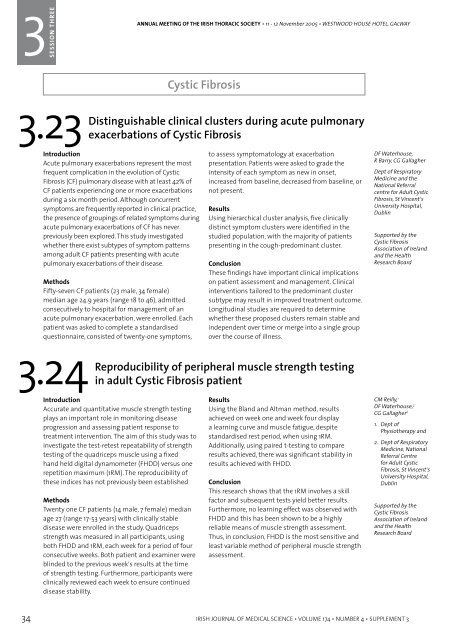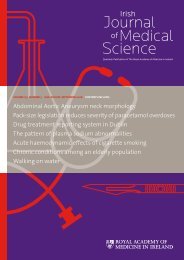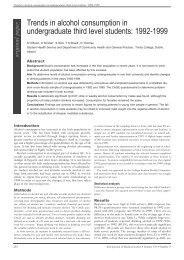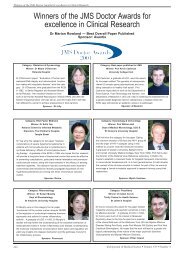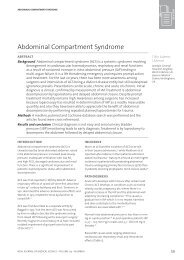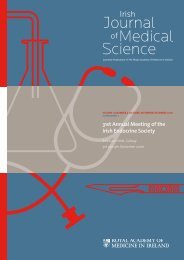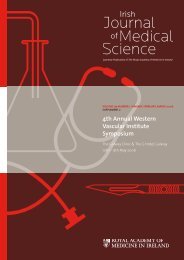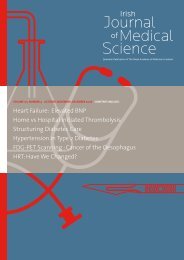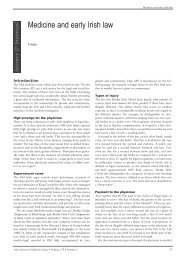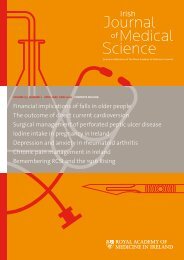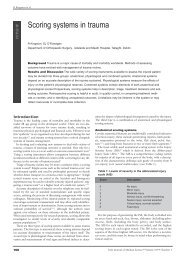Annual General Meeting of the Irish Thoracic Society - IJMS | Irish ...
Annual General Meeting of the Irish Thoracic Society - IJMS | Irish ...
Annual General Meeting of the Irish Thoracic Society - IJMS | Irish ...
You also want an ePaper? Increase the reach of your titles
YUMPU automatically turns print PDFs into web optimized ePapers that Google loves.
31<br />
1<br />
SESSION THREE ONE<br />
ANNUAL MEETING OF THE IRISH THORACIC SOCIETY • 11 - 12 November 2005 • WESTWOOD HOUSE HOTEL, GALWAY<br />
ANNUAL MEETING OF THE IRISH THORACIC SOCIETY • 11 - 12 November 2005 • WESTWOOD HOUSE HOTEL, GALWAY<br />
3<br />
SESSION<br />
SESSION THREE ONE<br />
Cystic Fibrosis<br />
3.23<br />
Distinguishable clinical clusters during acute pulmonary<br />
exacerbations <strong>of</strong> Cystic Fibrosis<br />
Introduction<br />
Acute pulmonary exacerbations represent <strong>the</strong> most<br />
frequent complication in <strong>the</strong> evolution <strong>of</strong> Cystic<br />
Fibrosis (CF) pulmonary disease with at least 42% <strong>of</strong><br />
CF patients experiencing one or more exacerbations<br />
during a six month period. Although concurrent<br />
symptoms are frequently reported in clinical practice,<br />
<strong>the</strong> presence <strong>of</strong> groupings <strong>of</strong> related symptoms during<br />
acute pulmonary exacerbations <strong>of</strong> CF has never<br />
previously been explored. This study investigated<br />
whe<strong>the</strong>r <strong>the</strong>re exist subtypes <strong>of</strong> symptom patterns<br />
among adult CF patients presenting with acute<br />
pulmonary exacerbations <strong>of</strong> <strong>the</strong>ir disease.<br />
Methods<br />
Fifty-seven CF patients (23 male, 34 female)<br />
median age 24.9 years (range 18 to 46), admitted<br />
consecutively to hospital for management <strong>of</strong> an<br />
acute pulmonary exacerbation, were enrolled. Each<br />
patient was asked to complete a standardised<br />
questionnaire, consisted <strong>of</strong> twenty-one symptoms,<br />
to assess symptomatology at exacerbation<br />
presentation. Patients were asked to grade <strong>the</strong><br />
intensity <strong>of</strong> each symptom as new in onset,<br />
increased from baseline, decreased from baseline, or<br />
not present.<br />
Results<br />
Using hierarchical cluster analysis, five clinically<br />
distinct symptom clusters were identified in <strong>the</strong><br />
studied population, with <strong>the</strong> majority <strong>of</strong> patients<br />
presenting in <strong>the</strong> cough-predominant cluster.<br />
Conclusion<br />
These findings have important clinical implications<br />
on patient assessment and management. Clinical<br />
interventions tailored to <strong>the</strong> predominant cluster<br />
subtype may result in improved treatment outcome.<br />
Longitudinal studies are required to determine<br />
whe<strong>the</strong>r <strong>the</strong>se proposed clusters remain stable and<br />
independent over time or merge into a single group<br />
over <strong>the</strong> course <strong>of</strong> illness.<br />
DF Waterhouse,<br />
R Barry, CG Gallagher<br />
Dept <strong>of</strong> Respiratory<br />
Medicine and <strong>the</strong><br />
National Referral<br />
centre for Adult Cystic<br />
Fibrosis, St Vincent’s<br />
University Hospital,<br />
Dublin<br />
Supported by <strong>the</strong><br />
Cystic Fibrosis<br />
Association <strong>of</strong> Ireland<br />
and <strong>the</strong> Health<br />
Research Board<br />
3.25<br />
The introduction <strong>of</strong> once daily tobramycin dosing at <strong>the</strong><br />
national referral centre for adult Cystic Fibrosis in<br />
St Vincent’s University Hospital, Dublin<br />
Introduction<br />
Due to its good activity against Pseudomonas<br />
aeruginosa, tobramycin is one <strong>of</strong> <strong>the</strong> most<br />
commonly used drugs to treat an infective<br />
exacerbation <strong>of</strong> Cystic Fibrosis. Following <strong>the</strong><br />
publication <strong>of</strong> <strong>the</strong> TOPIC study it was decided to<br />
introduce once daily dosing <strong>of</strong> tobramycin at <strong>the</strong><br />
National Referral Centre for Adult Cystic Fibrosis<br />
(NRCACF) in St. Vincent’s University Hospital.<br />
Method<br />
The first 43 patients to receive tobramycin oncedaily<br />
were studied intensively. Among <strong>the</strong> most<br />
important parameters studied were pre- and postdoes<br />
tobramycin levels, serum creatinine levels and<br />
<strong>the</strong> single daily dose administered, expressed per<br />
kilogram bodyweight.<br />
Results<br />
The results <strong>of</strong> <strong>the</strong> study showed that 79.1% <strong>of</strong><br />
patients received a tobramycin course in which <strong>the</strong><br />
recorded levels were within <strong>the</strong> <strong>the</strong>rapeutic range.<br />
This compares to just 50% <strong>of</strong> patients reaching<br />
<strong>the</strong>rapeutic levels in a previous study carried<br />
out in St. Vincent’s University Hospital in 2002,<br />
which involved three-times daily administration<br />
<strong>of</strong> tobramycin. Two patients in <strong>the</strong> current study<br />
showed tobramycin levels in <strong>the</strong> toxic range, while<br />
a fur<strong>the</strong>r four patients exhibited increases in serum<br />
creatinine suggestive <strong>of</strong> renal toxicity. There were no<br />
reports <strong>of</strong> ototoxicity during <strong>the</strong> study period.<br />
Conclusions<br />
The once-daily administration protocols compiled<br />
for <strong>the</strong> changeover from three-times daily to oncedaily<br />
tobramycin dosing ensured that <strong>the</strong> changeover<br />
occurred smoothly and with no disruption for<br />
patients. Switching to once daily tobramycin ensured<br />
that a higher proportion <strong>of</strong> patients achieved serum<br />
levels within <strong>the</strong> <strong>the</strong>rapeutic range.<br />
C Muldowney, C Keane<br />
Pharmacy Dept,<br />
St Vincent’s University<br />
Hospital, Dublin<br />
3.24<br />
Reproducibility <strong>of</strong> peripheral muscle strength testing<br />
in adult Cystic Fibrosis patient<br />
Introduction<br />
Accurate and quantitative muscle strength testing<br />
plays an important role in monitoring disease<br />
progression and assessing patient response to<br />
treatment intervention. The aim <strong>of</strong> this study was to<br />
investigate <strong>the</strong> test-retest repeatability <strong>of</strong> strength<br />
testing <strong>of</strong> <strong>the</strong> quadriceps muscle using a fixed<br />
hand held digital dynamometer (FHDD) versus one<br />
repetition maximum (1RM). The reproducibility <strong>of</strong><br />
<strong>the</strong>se indices has not previously been established<br />
Methods<br />
Twenty one CF patients (14 male, 7 female) median<br />
age 27 (range 17-53 years) with clinically stable<br />
disease were enrolled in <strong>the</strong> study. Quadriceps<br />
strength was measured in all participants, using<br />
both FHDD and 1RM, each week for a period <strong>of</strong> four<br />
consecutive weeks. Both patient and examiner were<br />
blinded to <strong>the</strong> previous week’s results at <strong>the</strong> time<br />
<strong>of</strong> strength testing. Fur<strong>the</strong>rmore, participants were<br />
clinically reviewed each week to ensure continued<br />
disease stability.<br />
Results<br />
Using <strong>the</strong> Bland and Altman method, results<br />
achieved on week one and week four display<br />
a learning curve and muscle fatigue, despite<br />
standardised rest period, when using 1RM.<br />
Additionally, using paired t-testing to compare<br />
results achieved, <strong>the</strong>re was significant stability in<br />
results achieved with FHDD.<br />
Conclusion<br />
This research shows that <strong>the</strong> 1RM involves a skill<br />
factor and subsequent tests yield better results.<br />
Fur<strong>the</strong>rmore, no learning effect was observed with<br />
FHDD and this has been shown to be a highly<br />
reliable means <strong>of</strong> muscle strength assessment.<br />
Thus, in conclusion, FHDD is <strong>the</strong> most sensitive and<br />
least variable method <strong>of</strong> peripheral muscle strength<br />
assessment.<br />
CM Reilly, 1<br />
DF Waterhouse, 2<br />
CG Gallagher 2<br />
1. Dept <strong>of</strong><br />
Physio<strong>the</strong>rapy and<br />
2. Dept <strong>of</strong> Respiratory<br />
Medicine, National<br />
Referral Centre<br />
for Adult Cystic<br />
Fibrosis, St Vincent’s<br />
University Hospital,<br />
Dublin<br />
Supported by <strong>the</strong><br />
Cystic Fibrosis<br />
Association <strong>of</strong> Ireland<br />
and <strong>the</strong> Health<br />
Research Board<br />
3.26<br />
Emergence <strong>of</strong> high grade tobramycin resistance in<br />
P. aeruginosa isolates in <strong>the</strong> sputum <strong>of</strong> children on<br />
bedulised tobramycin solution for inhalation<br />
Background<br />
Chronic enbronchial infection with Pseudomonas<br />
aeruginosa (PA) is associated with a deterioration<br />
in lung function in patients with Cystic Fibrosis.<br />
Preservative-free tobramycin for inhalation (TOBI®)<br />
has been recently developed as maintenance<br />
anti-pseudomonal antibiotic. Randomised trials<br />
<strong>of</strong> alternate month use have shown beneficial<br />
effects on pulmonary function and weight gain,<br />
and reduction <strong>of</strong> bacterial load. Clinically significant<br />
high grade resistance has not been described. We<br />
previously reported <strong>the</strong> beneficial clinical effects<br />
<strong>of</strong> TOBI in our CF patient population. Like o<strong>the</strong>r<br />
investigators, we noted an increase in low grade<br />
(10mcg/ml) resistance to tobramycin. However<br />
high grade (200mcg/ml) resistance <strong>of</strong> P Aeruginosa<br />
isolates was not observed at that time.<br />
Aims<br />
The purpose <strong>of</strong> this study was to evaluate PA isolates<br />
for <strong>the</strong> presence <strong>of</strong> high grade TOBI resistance and<br />
if confirmed, to determine what, if any clinical<br />
parameters could be identified as risk factors for its<br />
development.<br />
Method<br />
A retrospective chart review was conducted on all<br />
children with a persistent growth <strong>of</strong> PA who were<br />
receiving TOBI. The following data was recorded<br />
subsequent to starting on treatment: Anthropometric<br />
indices, genotype, antibiotic resistance <strong>of</strong> PA<br />
strains, number <strong>of</strong> IV antibiotic courses, use <strong>of</strong> IV<br />
aminoglycosides and use <strong>of</strong> IV tobramycin.<br />
Results<br />
Twenty six patients with PA infection were being<br />
treated with TOBI. The mean duration <strong>of</strong> treatment<br />
at <strong>the</strong> time <strong>of</strong> study was 33 months. Low grade<br />
resistance developed in 16 patients, 8 <strong>of</strong> whom went<br />
on to develop high grade resistance. Mean duration<br />
to development <strong>of</strong> consistent low grade resistance<br />
was 15.6 months and to high grade resistance was<br />
P McNally, G Leen,<br />
M Doyle, P Murphy,<br />
P Greally<br />
Dept <strong>of</strong> Cystic Fibrosis<br />
National Children’s<br />
Hospital, Talaght,<br />
Dublin<br />
34 IRISH JOURNAL OF MEDICAL SCIENCE • VOLUME 174 • NUMBER 4 • SUPPLEMENT 3<br />
IRISH JOURNAL OF MEDICAL SCIENCE • VOLUME 174 • NUMBER 4 • SUPPLEMENT 3 35


